Business Finance Report: Working Capital and Budgeting Strategies
VerifiedAdded on 2023/01/18
|13
|3473
|68
Report
AI Summary
This comprehensive business finance report delves into the intricacies of working capital management, cash flow analysis, and budgeting methods, using Brightlawn Plc and Boatworld Plc as case studies. Part 1 examines the differences between profit and cash flow, defines key working capital comp...
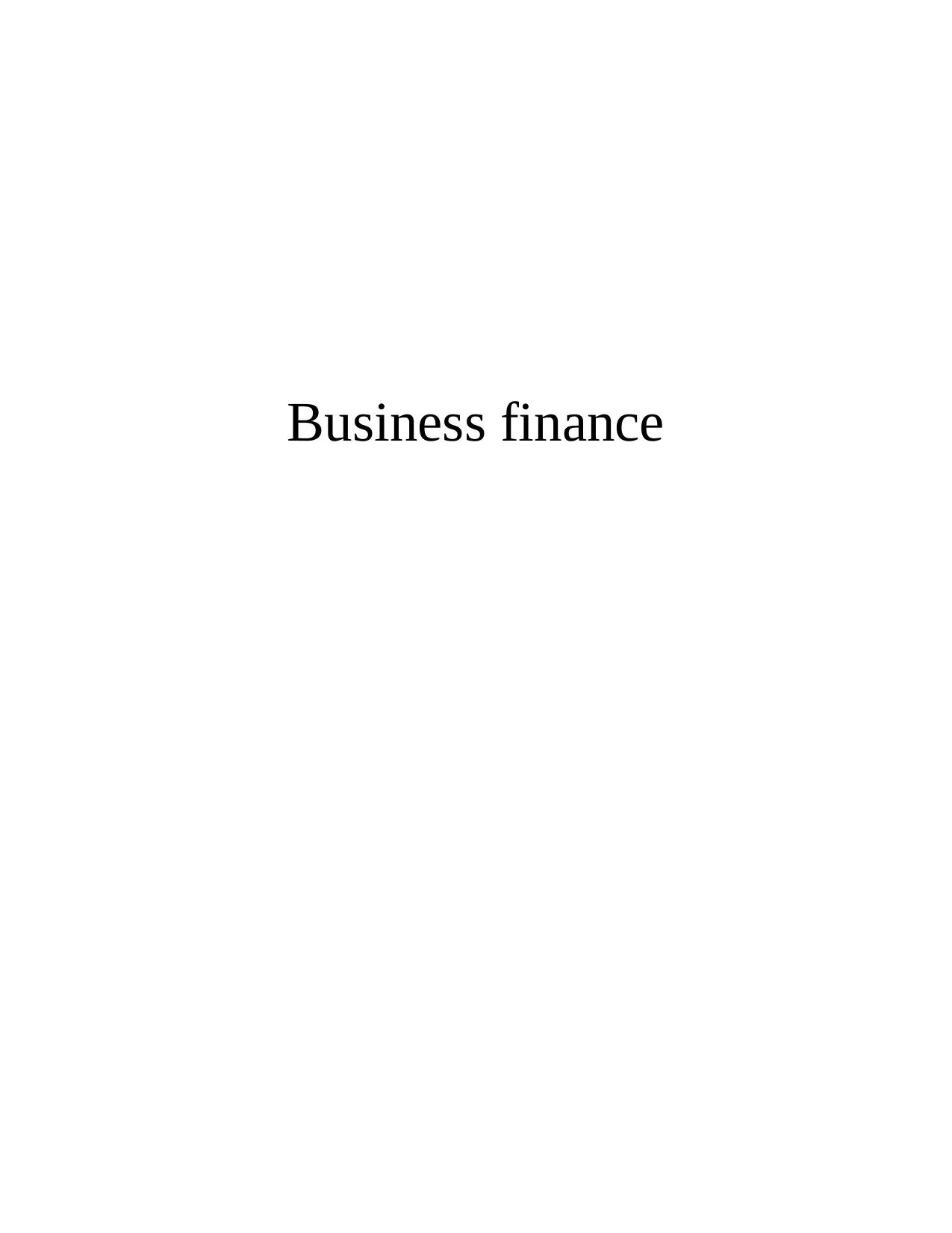
Business finance
Paraphrase This Document
Need a fresh take? Get an instant paraphrase of this document with our AI Paraphraser
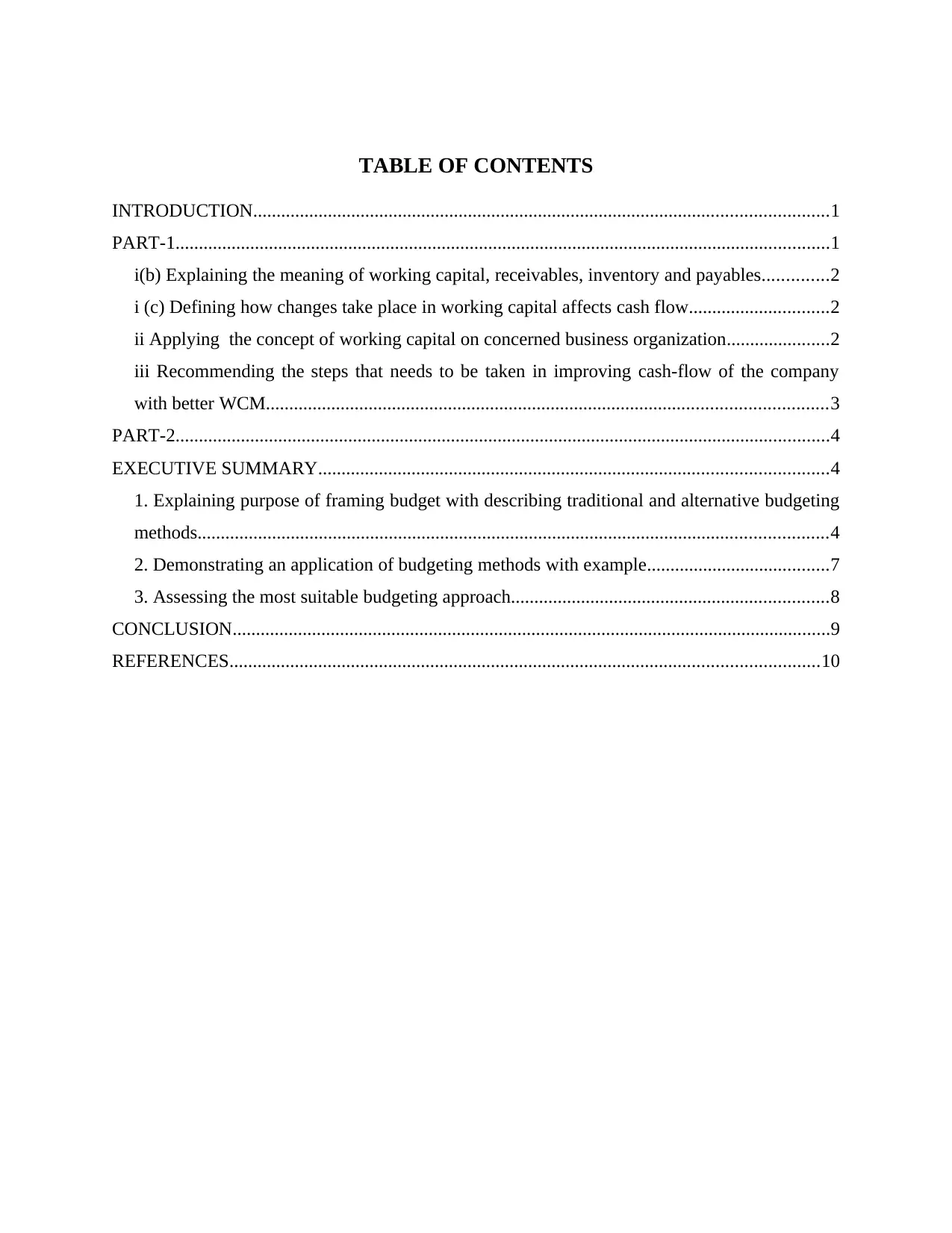
TABLE OF CONTENTS
INTRODUCTION...........................................................................................................................1
PART-1............................................................................................................................................1
i(b) Explaining the meaning of working capital, receivables, inventory and payables..............2
i (c) Defining how changes take place in working capital affects cash flow..............................2
ii Applying the concept of working capital on concerned business organization......................2
iii Recommending the steps that needs to be taken in improving cash-flow of the company
with better WCM........................................................................................................................3
PART-2............................................................................................................................................4
EXECUTIVE SUMMARY.............................................................................................................4
1. Explaining purpose of framing budget with describing traditional and alternative budgeting
methods.......................................................................................................................................4
2. Demonstrating an application of budgeting methods with example.......................................7
3. Assessing the most suitable budgeting approach....................................................................8
CONCLUSION................................................................................................................................9
REFERENCES..............................................................................................................................10
INTRODUCTION...........................................................................................................................1
PART-1............................................................................................................................................1
i(b) Explaining the meaning of working capital, receivables, inventory and payables..............2
i (c) Defining how changes take place in working capital affects cash flow..............................2
ii Applying the concept of working capital on concerned business organization......................2
iii Recommending the steps that needs to be taken in improving cash-flow of the company
with better WCM........................................................................................................................3
PART-2............................................................................................................................................4
EXECUTIVE SUMMARY.............................................................................................................4
1. Explaining purpose of framing budget with describing traditional and alternative budgeting
methods.......................................................................................................................................4
2. Demonstrating an application of budgeting methods with example.......................................7
3. Assessing the most suitable budgeting approach....................................................................8
CONCLUSION................................................................................................................................9
REFERENCES..............................................................................................................................10
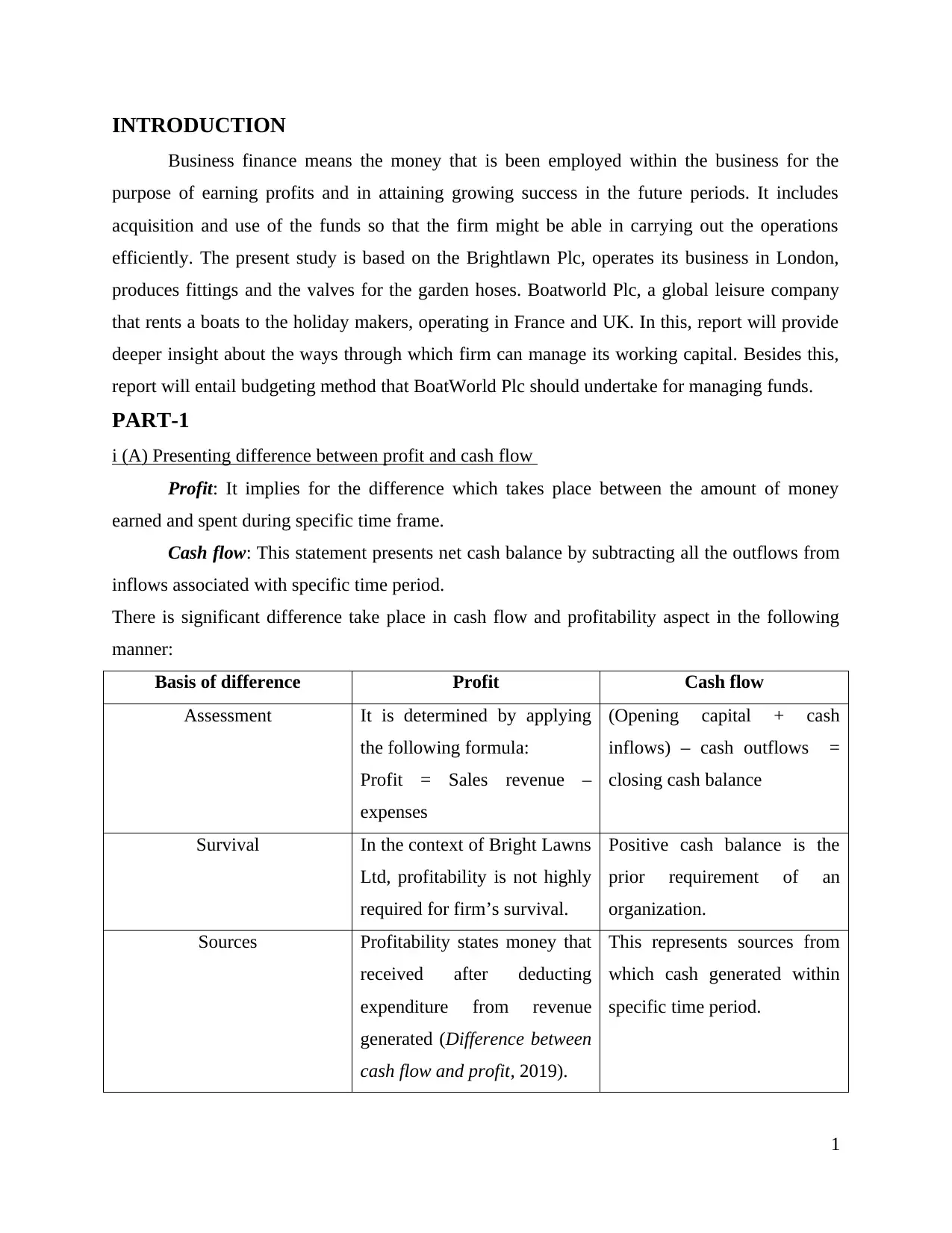
INTRODUCTION
Business finance means the money that is been employed within the business for the
purpose of earning profits and in attaining growing success in the future periods. It includes
acquisition and use of the funds so that the firm might be able in carrying out the operations
efficiently. The present study is based on the Brightlawn Plc, operates its business in London,
produces fittings and the valves for the garden hoses. Boatworld Plc, a global leisure company
that rents a boats to the holiday makers, operating in France and UK. In this, report will provide
deeper insight about the ways through which firm can manage its working capital. Besides this,
report will entail budgeting method that BoatWorld Plc should undertake for managing funds.
PART-1
i (A) Presenting difference between profit and cash flow
Profit: It implies for the difference which takes place between the amount of money
earned and spent during specific time frame.
Cash flow: This statement presents net cash balance by subtracting all the outflows from
inflows associated with specific time period.
There is significant difference take place in cash flow and profitability aspect in the following
manner:
Basis of difference Profit Cash flow
Assessment It is determined by applying
the following formula:
Profit = Sales revenue –
expenses
(Opening capital + cash
inflows) – cash outflows =
closing cash balance
Survival In the context of Bright Lawns
Ltd, profitability is not highly
required for firm’s survival.
Positive cash balance is the
prior requirement of an
organization.
Sources Profitability states money that
received after deducting
expenditure from revenue
generated (Difference between
cash flow and profit, 2019).
This represents sources from
which cash generated within
specific time period.
1
Business finance means the money that is been employed within the business for the
purpose of earning profits and in attaining growing success in the future periods. It includes
acquisition and use of the funds so that the firm might be able in carrying out the operations
efficiently. The present study is based on the Brightlawn Plc, operates its business in London,
produces fittings and the valves for the garden hoses. Boatworld Plc, a global leisure company
that rents a boats to the holiday makers, operating in France and UK. In this, report will provide
deeper insight about the ways through which firm can manage its working capital. Besides this,
report will entail budgeting method that BoatWorld Plc should undertake for managing funds.
PART-1
i (A) Presenting difference between profit and cash flow
Profit: It implies for the difference which takes place between the amount of money
earned and spent during specific time frame.
Cash flow: This statement presents net cash balance by subtracting all the outflows from
inflows associated with specific time period.
There is significant difference take place in cash flow and profitability aspect in the following
manner:
Basis of difference Profit Cash flow
Assessment It is determined by applying
the following formula:
Profit = Sales revenue –
expenses
(Opening capital + cash
inflows) – cash outflows =
closing cash balance
Survival In the context of Bright Lawns
Ltd, profitability is not highly
required for firm’s survival.
Positive cash balance is the
prior requirement of an
organization.
Sources Profitability states money that
received after deducting
expenditure from revenue
generated (Difference between
cash flow and profit, 2019).
This represents sources from
which cash generated within
specific time period.
1
⊘ This is a preview!⊘
Do you want full access?
Subscribe today to unlock all pages.

Trusted by 1+ million students worldwide
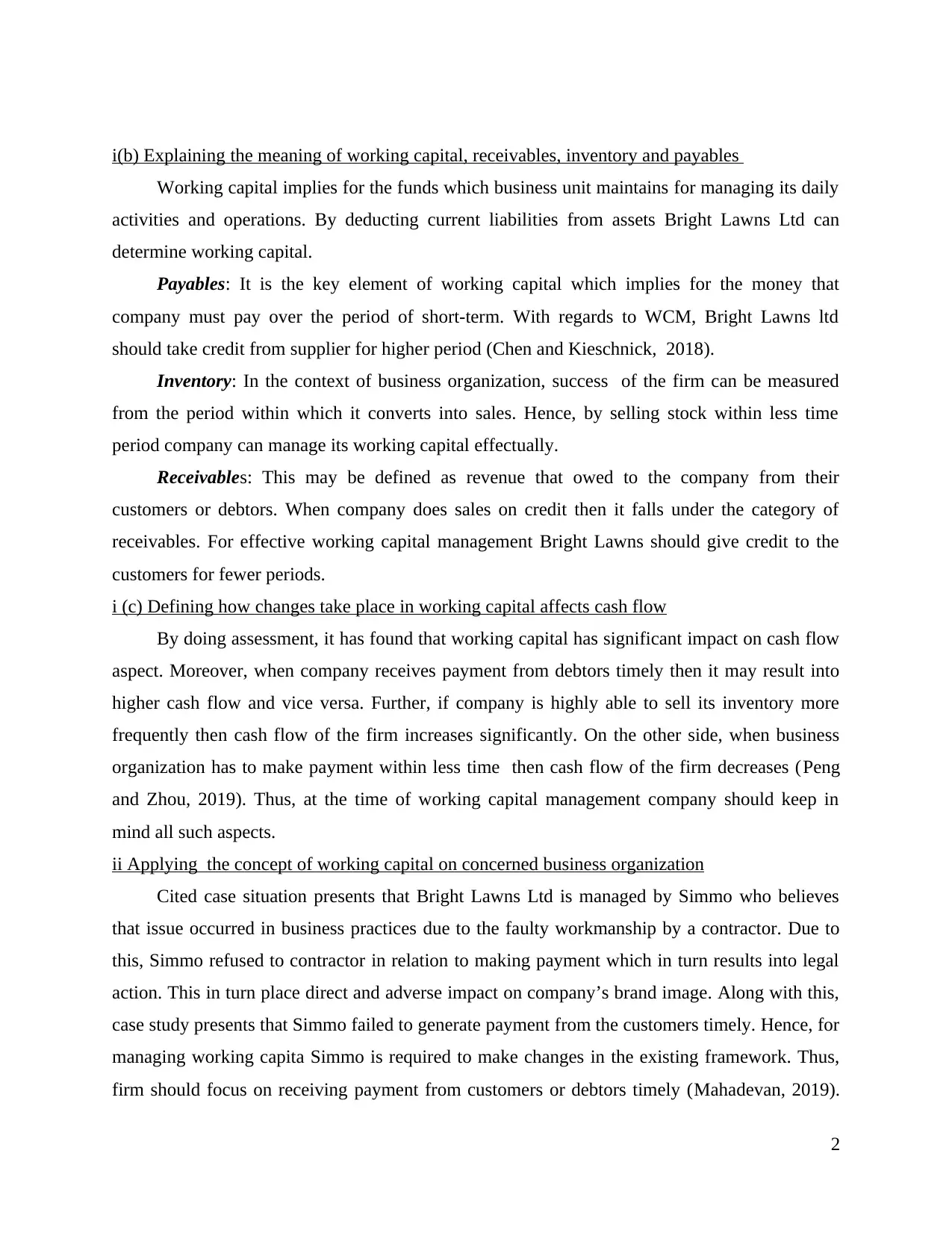
i(b) Explaining the meaning of working capital, receivables, inventory and payables
Working capital implies for the funds which business unit maintains for managing its daily
activities and operations. By deducting current liabilities from assets Bright Lawns Ltd can
determine working capital.
Payables: It is the key element of working capital which implies for the money that
company must pay over the period of short-term. With regards to WCM, Bright Lawns ltd
should take credit from supplier for higher period (Chen and Kieschnick, 2018).
Inventory: In the context of business organization, success of the firm can be measured
from the period within which it converts into sales. Hence, by selling stock within less time
period company can manage its working capital effectually.
Receivables: This may be defined as revenue that owed to the company from their
customers or debtors. When company does sales on credit then it falls under the category of
receivables. For effective working capital management Bright Lawns should give credit to the
customers for fewer periods.
i (c) Defining how changes take place in working capital affects cash flow
By doing assessment, it has found that working capital has significant impact on cash flow
aspect. Moreover, when company receives payment from debtors timely then it may result into
higher cash flow and vice versa. Further, if company is highly able to sell its inventory more
frequently then cash flow of the firm increases significantly. On the other side, when business
organization has to make payment within less time then cash flow of the firm decreases (Peng
and Zhou, 2019). Thus, at the time of working capital management company should keep in
mind all such aspects.
ii Applying the concept of working capital on concerned business organization
Cited case situation presents that Bright Lawns Ltd is managed by Simmo who believes
that issue occurred in business practices due to the faulty workmanship by a contractor. Due to
this, Simmo refused to contractor in relation to making payment which in turn results into legal
action. This in turn place direct and adverse impact on company’s brand image. Along with this,
case study presents that Simmo failed to generate payment from the customers timely. Hence, for
managing working capita Simmo is required to make changes in the existing framework. Thus,
firm should focus on receiving payment from customers or debtors timely (Mahadevan, 2019).
2
Working capital implies for the funds which business unit maintains for managing its daily
activities and operations. By deducting current liabilities from assets Bright Lawns Ltd can
determine working capital.
Payables: It is the key element of working capital which implies for the money that
company must pay over the period of short-term. With regards to WCM, Bright Lawns ltd
should take credit from supplier for higher period (Chen and Kieschnick, 2018).
Inventory: In the context of business organization, success of the firm can be measured
from the period within which it converts into sales. Hence, by selling stock within less time
period company can manage its working capital effectually.
Receivables: This may be defined as revenue that owed to the company from their
customers or debtors. When company does sales on credit then it falls under the category of
receivables. For effective working capital management Bright Lawns should give credit to the
customers for fewer periods.
i (c) Defining how changes take place in working capital affects cash flow
By doing assessment, it has found that working capital has significant impact on cash flow
aspect. Moreover, when company receives payment from debtors timely then it may result into
higher cash flow and vice versa. Further, if company is highly able to sell its inventory more
frequently then cash flow of the firm increases significantly. On the other side, when business
organization has to make payment within less time then cash flow of the firm decreases (Peng
and Zhou, 2019). Thus, at the time of working capital management company should keep in
mind all such aspects.
ii Applying the concept of working capital on concerned business organization
Cited case situation presents that Bright Lawns Ltd is managed by Simmo who believes
that issue occurred in business practices due to the faulty workmanship by a contractor. Due to
this, Simmo refused to contractor in relation to making payment which in turn results into legal
action. This in turn place direct and adverse impact on company’s brand image. Along with this,
case study presents that Simmo failed to generate payment from the customers timely. Hence, for
managing working capita Simmo is required to make changes in the existing framework. Thus,
firm should focus on receiving payment from customers or debtors timely (Mahadevan, 2019).
2
Paraphrase This Document
Need a fresh take? Get an instant paraphrase of this document with our AI Paraphraser
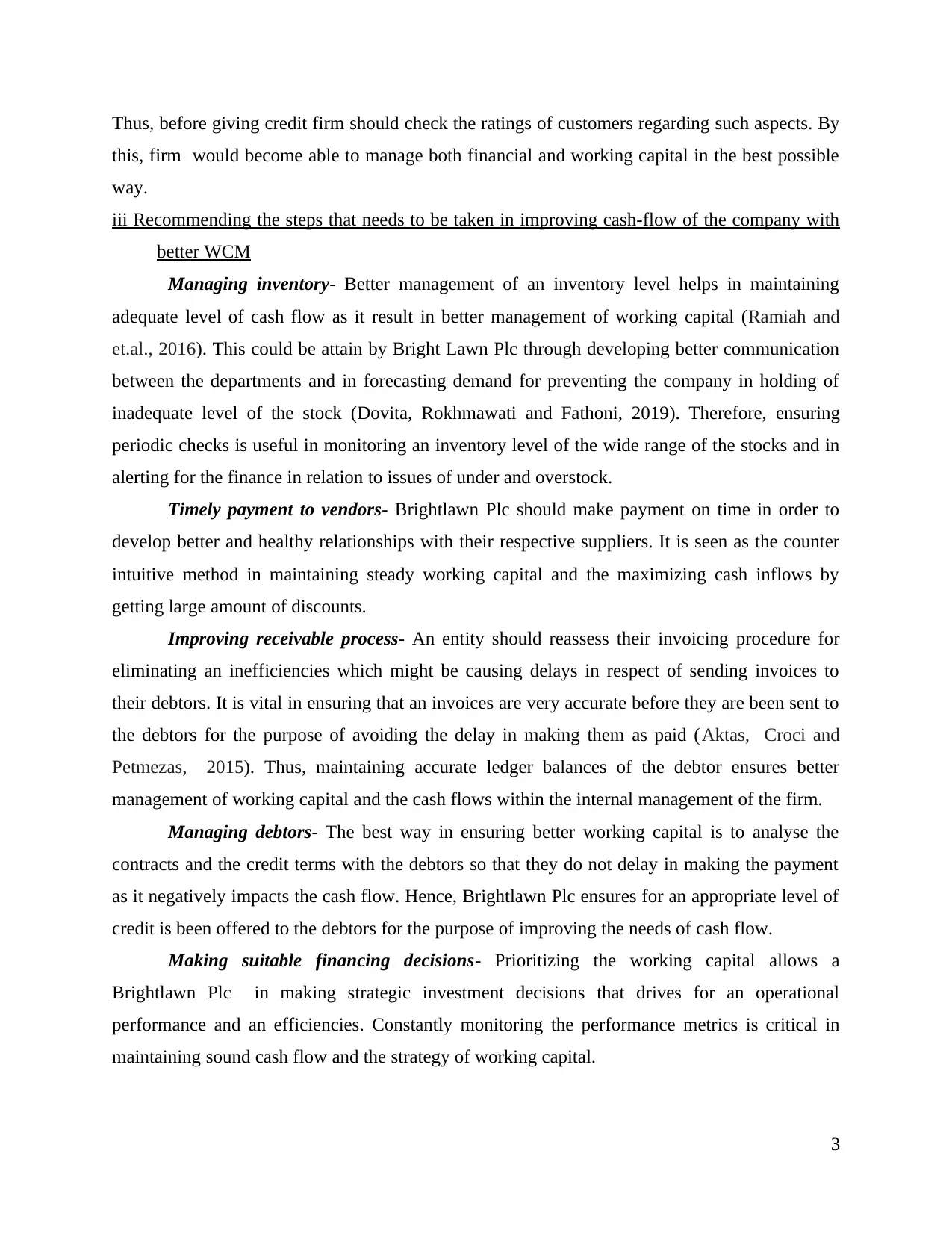
Thus, before giving credit firm should check the ratings of customers regarding such aspects. By
this, firm would become able to manage both financial and working capital in the best possible
way.
iii Recommending the steps that needs to be taken in improving cash-flow of the company with
better WCM
Managing inventory- Better management of an inventory level helps in maintaining
adequate level of cash flow as it result in better management of working capital (Ramiah and
et.al., 2016). This could be attain by Bright Lawn Plc through developing better communication
between the departments and in forecasting demand for preventing the company in holding of
inadequate level of the stock (Dovita, Rokhmawati and Fathoni, 2019). Therefore, ensuring
periodic checks is useful in monitoring an inventory level of the wide range of the stocks and in
alerting for the finance in relation to issues of under and overstock.
Timely payment to vendors- Brightlawn Plc should make payment on time in order to
develop better and healthy relationships with their respective suppliers. It is seen as the counter
intuitive method in maintaining steady working capital and the maximizing cash inflows by
getting large amount of discounts.
Improving receivable process- An entity should reassess their invoicing procedure for
eliminating an inefficiencies which might be causing delays in respect of sending invoices to
their debtors. It is vital in ensuring that an invoices are very accurate before they are been sent to
the debtors for the purpose of avoiding the delay in making them as paid (Aktas, Croci and
Petmezas, 2015). Thus, maintaining accurate ledger balances of the debtor ensures better
management of working capital and the cash flows within the internal management of the firm.
Managing debtors- The best way in ensuring better working capital is to analyse the
contracts and the credit terms with the debtors so that they do not delay in making the payment
as it negatively impacts the cash flow. Hence, Brightlawn Plc ensures for an appropriate level of
credit is been offered to the debtors for the purpose of improving the needs of cash flow.
Making suitable financing decisions- Prioritizing the working capital allows a
Brightlawn Plc in making strategic investment decisions that drives for an operational
performance and an efficiencies. Constantly monitoring the performance metrics is critical in
maintaining sound cash flow and the strategy of working capital.
3
this, firm would become able to manage both financial and working capital in the best possible
way.
iii Recommending the steps that needs to be taken in improving cash-flow of the company with
better WCM
Managing inventory- Better management of an inventory level helps in maintaining
adequate level of cash flow as it result in better management of working capital (Ramiah and
et.al., 2016). This could be attain by Bright Lawn Plc through developing better communication
between the departments and in forecasting demand for preventing the company in holding of
inadequate level of the stock (Dovita, Rokhmawati and Fathoni, 2019). Therefore, ensuring
periodic checks is useful in monitoring an inventory level of the wide range of the stocks and in
alerting for the finance in relation to issues of under and overstock.
Timely payment to vendors- Brightlawn Plc should make payment on time in order to
develop better and healthy relationships with their respective suppliers. It is seen as the counter
intuitive method in maintaining steady working capital and the maximizing cash inflows by
getting large amount of discounts.
Improving receivable process- An entity should reassess their invoicing procedure for
eliminating an inefficiencies which might be causing delays in respect of sending invoices to
their debtors. It is vital in ensuring that an invoices are very accurate before they are been sent to
the debtors for the purpose of avoiding the delay in making them as paid (Aktas, Croci and
Petmezas, 2015). Thus, maintaining accurate ledger balances of the debtor ensures better
management of working capital and the cash flows within the internal management of the firm.
Managing debtors- The best way in ensuring better working capital is to analyse the
contracts and the credit terms with the debtors so that they do not delay in making the payment
as it negatively impacts the cash flow. Hence, Brightlawn Plc ensures for an appropriate level of
credit is been offered to the debtors for the purpose of improving the needs of cash flow.
Making suitable financing decisions- Prioritizing the working capital allows a
Brightlawn Plc in making strategic investment decisions that drives for an operational
performance and an efficiencies. Constantly monitoring the performance metrics is critical in
maintaining sound cash flow and the strategy of working capital.
3
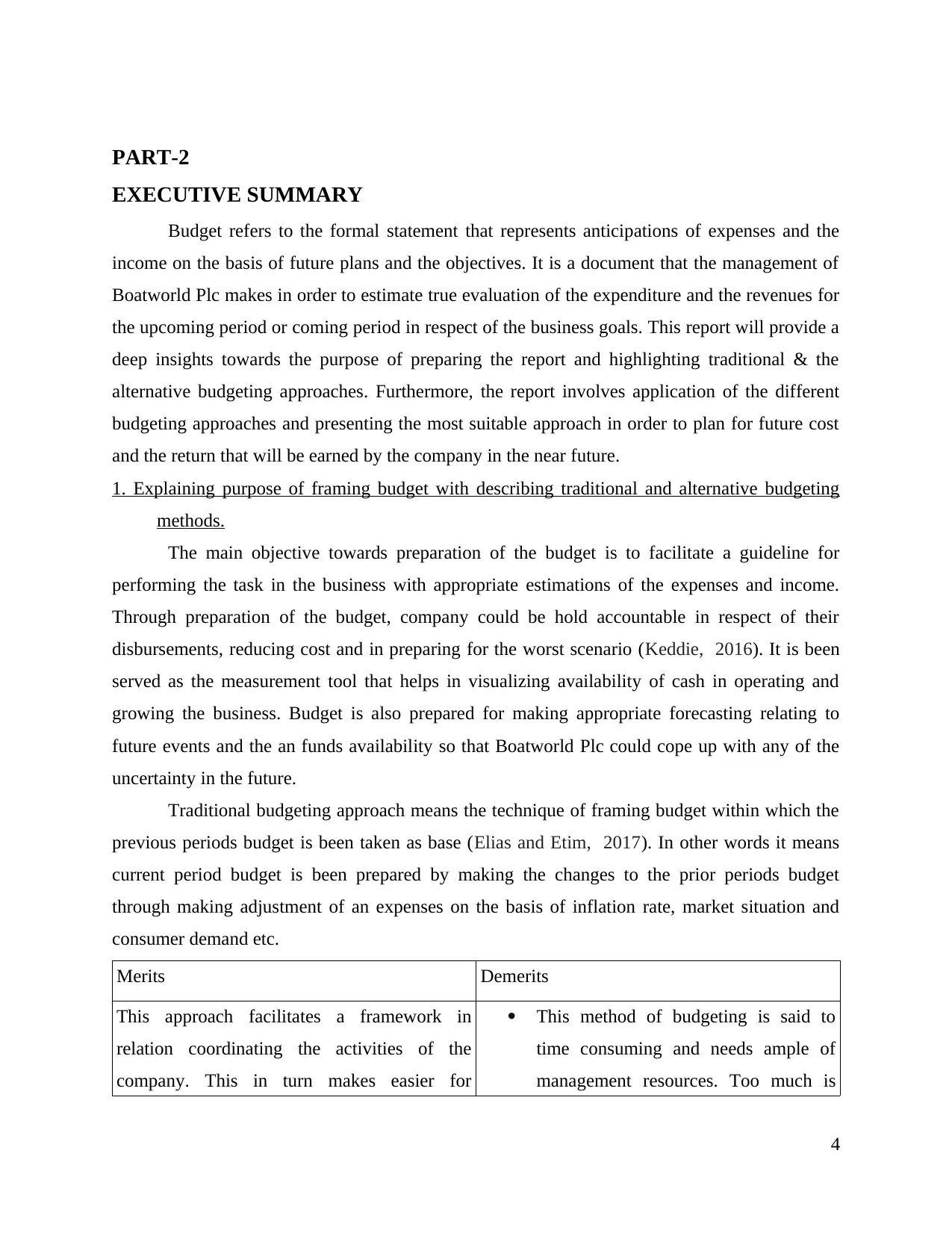
PART-2
EXECUTIVE SUMMARY
Budget refers to the formal statement that represents anticipations of expenses and the
income on the basis of future plans and the objectives. It is a document that the management of
Boatworld Plc makes in order to estimate true evaluation of the expenditure and the revenues for
the upcoming period or coming period in respect of the business goals. This report will provide a
deep insights towards the purpose of preparing the report and highlighting traditional & the
alternative budgeting approaches. Furthermore, the report involves application of the different
budgeting approaches and presenting the most suitable approach in order to plan for future cost
and the return that will be earned by the company in the near future.
1. Explaining purpose of framing budget with describing traditional and alternative budgeting
methods.
The main objective towards preparation of the budget is to facilitate a guideline for
performing the task in the business with appropriate estimations of the expenses and income.
Through preparation of the budget, company could be hold accountable in respect of their
disbursements, reducing cost and in preparing for the worst scenario (Keddie, 2016). It is been
served as the measurement tool that helps in visualizing availability of cash in operating and
growing the business. Budget is also prepared for making appropriate forecasting relating to
future events and the an funds availability so that Boatworld Plc could cope up with any of the
uncertainty in the future.
Traditional budgeting approach means the technique of framing budget within which the
previous periods budget is been taken as base (Elias and Etim, 2017). In other words it means
current period budget is been prepared by making the changes to the prior periods budget
through making adjustment of an expenses on the basis of inflation rate, market situation and
consumer demand etc.
Merits Demerits
This approach facilitates a framework in
relation coordinating the activities of the
company. This in turn makes easier for
This method of budgeting is said to
time consuming and needs ample of
management resources. Too much is
4
EXECUTIVE SUMMARY
Budget refers to the formal statement that represents anticipations of expenses and the
income on the basis of future plans and the objectives. It is a document that the management of
Boatworld Plc makes in order to estimate true evaluation of the expenditure and the revenues for
the upcoming period or coming period in respect of the business goals. This report will provide a
deep insights towards the purpose of preparing the report and highlighting traditional & the
alternative budgeting approaches. Furthermore, the report involves application of the different
budgeting approaches and presenting the most suitable approach in order to plan for future cost
and the return that will be earned by the company in the near future.
1. Explaining purpose of framing budget with describing traditional and alternative budgeting
methods.
The main objective towards preparation of the budget is to facilitate a guideline for
performing the task in the business with appropriate estimations of the expenses and income.
Through preparation of the budget, company could be hold accountable in respect of their
disbursements, reducing cost and in preparing for the worst scenario (Keddie, 2016). It is been
served as the measurement tool that helps in visualizing availability of cash in operating and
growing the business. Budget is also prepared for making appropriate forecasting relating to
future events and the an funds availability so that Boatworld Plc could cope up with any of the
uncertainty in the future.
Traditional budgeting approach means the technique of framing budget within which the
previous periods budget is been taken as base (Elias and Etim, 2017). In other words it means
current period budget is been prepared by making the changes to the prior periods budget
through making adjustment of an expenses on the basis of inflation rate, market situation and
consumer demand etc.
Merits Demerits
This approach facilitates a framework in
relation coordinating the activities of the
company. This in turn makes easier for
This method of budgeting is said to
time consuming and needs ample of
management resources. Too much is
4
⊘ This is a preview!⊘
Do you want full access?
Subscribe today to unlock all pages.

Trusted by 1+ million students worldwide
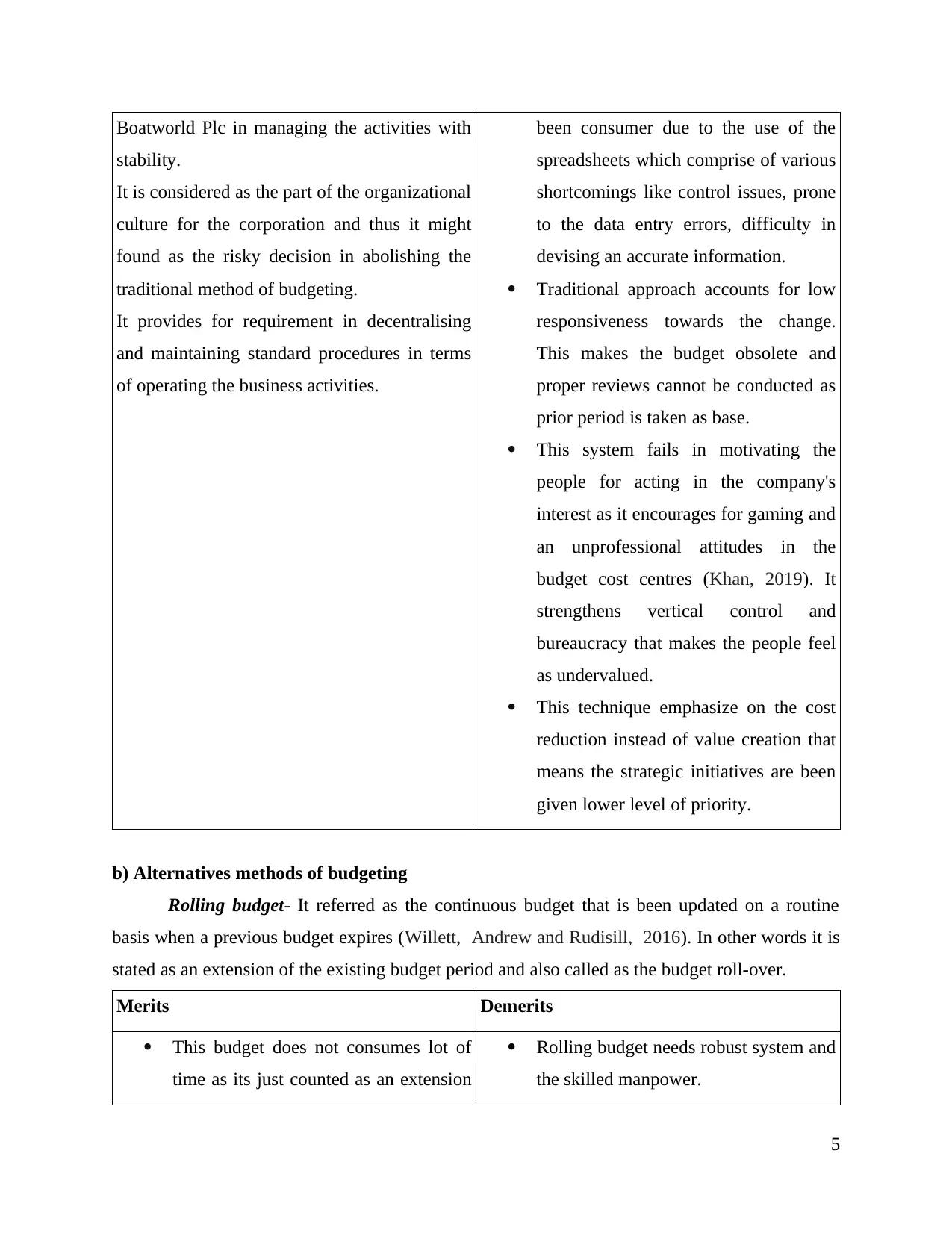
Boatworld Plc in managing the activities with
stability.
It is considered as the part of the organizational
culture for the corporation and thus it might
found as the risky decision in abolishing the
traditional method of budgeting.
It provides for requirement in decentralising
and maintaining standard procedures in terms
of operating the business activities.
been consumer due to the use of the
spreadsheets which comprise of various
shortcomings like control issues, prone
to the data entry errors, difficulty in
devising an accurate information.
Traditional approach accounts for low
responsiveness towards the change.
This makes the budget obsolete and
proper reviews cannot be conducted as
prior period is taken as base.
This system fails in motivating the
people for acting in the company's
interest as it encourages for gaming and
an unprofessional attitudes in the
budget cost centres (Khan, 2019). It
strengthens vertical control and
bureaucracy that makes the people feel
as undervalued.
This technique emphasize on the cost
reduction instead of value creation that
means the strategic initiatives are been
given lower level of priority.
b) Alternatives methods of budgeting
Rolling budget- It referred as the continuous budget that is been updated on a routine
basis when a previous budget expires (Willett, Andrew and Rudisill, 2016). In other words it is
stated as an extension of the existing budget period and also called as the budget roll-over.
Merits Demerits
This budget does not consumes lot of
time as its just counted as an extension
Rolling budget needs robust system and
the skilled manpower.
5
stability.
It is considered as the part of the organizational
culture for the corporation and thus it might
found as the risky decision in abolishing the
traditional method of budgeting.
It provides for requirement in decentralising
and maintaining standard procedures in terms
of operating the business activities.
been consumer due to the use of the
spreadsheets which comprise of various
shortcomings like control issues, prone
to the data entry errors, difficulty in
devising an accurate information.
Traditional approach accounts for low
responsiveness towards the change.
This makes the budget obsolete and
proper reviews cannot be conducted as
prior period is taken as base.
This system fails in motivating the
people for acting in the company's
interest as it encourages for gaming and
an unprofessional attitudes in the
budget cost centres (Khan, 2019). It
strengthens vertical control and
bureaucracy that makes the people feel
as undervalued.
This technique emphasize on the cost
reduction instead of value creation that
means the strategic initiatives are been
given lower level of priority.
b) Alternatives methods of budgeting
Rolling budget- It referred as the continuous budget that is been updated on a routine
basis when a previous budget expires (Willett, Andrew and Rudisill, 2016). In other words it is
stated as an extension of the existing budget period and also called as the budget roll-over.
Merits Demerits
This budget does not consumes lot of
time as its just counted as an extension
Rolling budget needs robust system and
the skilled manpower.
5
Paraphrase This Document
Need a fresh take? Get an instant paraphrase of this document with our AI Paraphraser

of the previous budget with appropriate
changes.
In the rolling budget, changing the
budget tends to be easy in case an
uncertain event occurs.
Rolling budget enables Boatworld Plc
in analysing their actual performance
against the budgeted.
It brings a better understanding,
objectives and the responsibility among
the employees of an enterprise.
It helps in finding out the strength and
the weaknesses of the firm and as per
such findings appropriate steps could
be taken in removing weaknesses.
It creates confusion and disturbs an
employee due to the consistent changes.
This budget is not seems as advisable
for those companies where the
circumstances are not been changing
frequently.
In case the target sets in the budget are
seen as difficult in achieving then it
results in demotivation among the
members of an entity.
Rolling budget is a costly affair as it
needs additional manpower in updating
the budget on the regular basis.
Zero based budget- It is the method in which all the expenses are been justified for every
new period (Raudla and Savi, 2015). The process of the zero based budget begins from the
scratch or zero base and each function within the company is assessed for its cost and needs.
Merits Demerits
This tool is highly useful as it helps
Boatworld Plc in saving the cost due to
inefficient operations.
As the resources under this method are
allocated on the basis of cost benefit
terms so this leads to better use of the
resources.
It forces a management executives at
all the levels for an active participation
in the process of budgeting.
Through this tool, managers of
Boatworld Plc might develop fear and
oppose to the new ideas and the
changes.
More and more parer work is been
involved in framing of the zero based
budget.
This budgeting technique results in
personal bias in terms of ranking the
decision packages.
6
changes.
In the rolling budget, changing the
budget tends to be easy in case an
uncertain event occurs.
Rolling budget enables Boatworld Plc
in analysing their actual performance
against the budgeted.
It brings a better understanding,
objectives and the responsibility among
the employees of an enterprise.
It helps in finding out the strength and
the weaknesses of the firm and as per
such findings appropriate steps could
be taken in removing weaknesses.
It creates confusion and disturbs an
employee due to the consistent changes.
This budget is not seems as advisable
for those companies where the
circumstances are not been changing
frequently.
In case the target sets in the budget are
seen as difficult in achieving then it
results in demotivation among the
members of an entity.
Rolling budget is a costly affair as it
needs additional manpower in updating
the budget on the regular basis.
Zero based budget- It is the method in which all the expenses are been justified for every
new period (Raudla and Savi, 2015). The process of the zero based budget begins from the
scratch or zero base and each function within the company is assessed for its cost and needs.
Merits Demerits
This tool is highly useful as it helps
Boatworld Plc in saving the cost due to
inefficient operations.
As the resources under this method are
allocated on the basis of cost benefit
terms so this leads to better use of the
resources.
It forces a management executives at
all the levels for an active participation
in the process of budgeting.
Through this tool, managers of
Boatworld Plc might develop fear and
oppose to the new ideas and the
changes.
More and more parer work is been
involved in framing of the zero based
budget.
This budgeting technique results in
personal bias in terms of ranking the
decision packages.
6
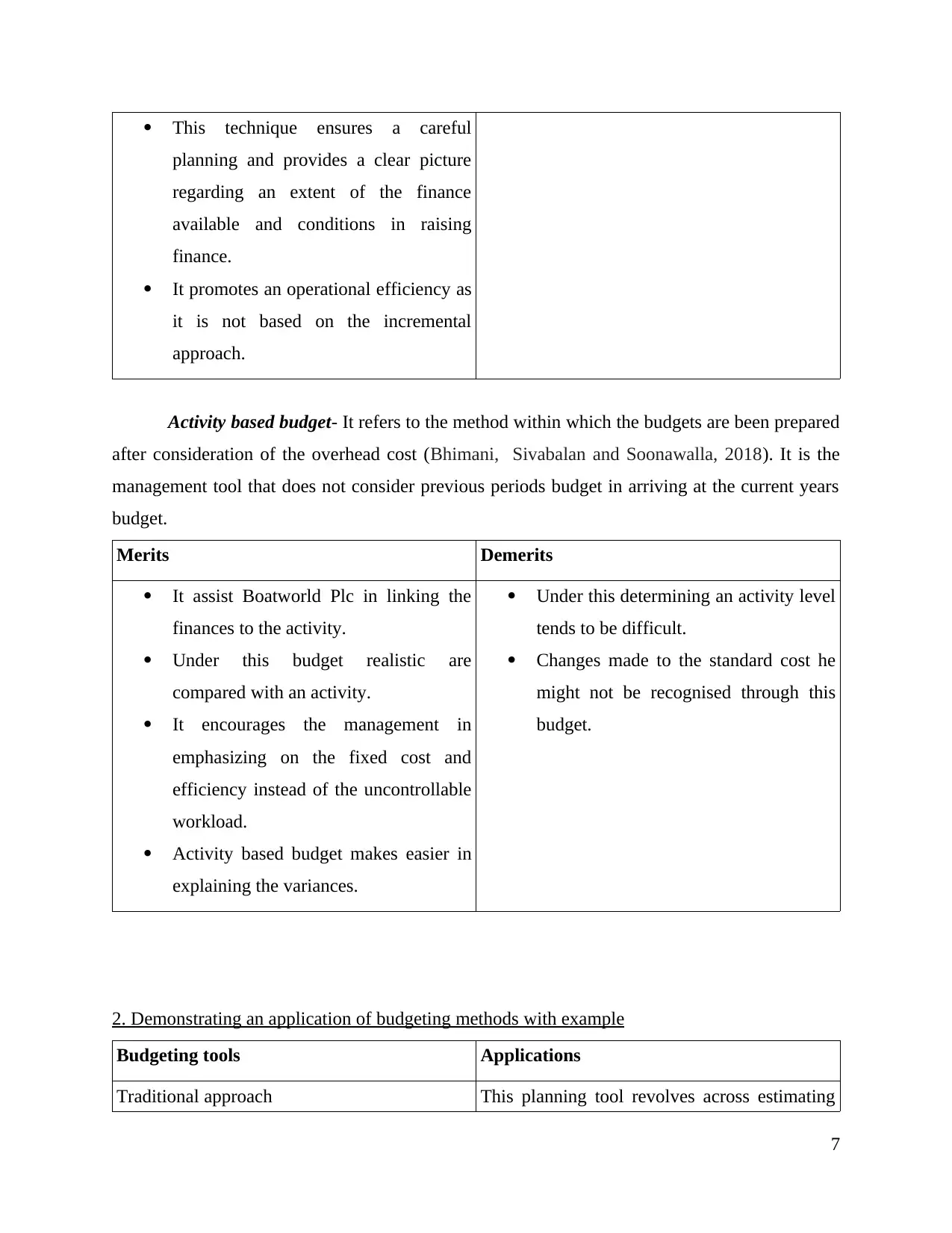
This technique ensures a careful
planning and provides a clear picture
regarding an extent of the finance
available and conditions in raising
finance.
It promotes an operational efficiency as
it is not based on the incremental
approach.
Activity based budget- It refers to the method within which the budgets are been prepared
after consideration of the overhead cost (Bhimani, Sivabalan and Soonawalla, 2018). It is the
management tool that does not consider previous periods budget in arriving at the current years
budget.
Merits Demerits
It assist Boatworld Plc in linking the
finances to the activity.
Under this budget realistic are
compared with an activity.
It encourages the management in
emphasizing on the fixed cost and
efficiency instead of the uncontrollable
workload.
Activity based budget makes easier in
explaining the variances.
Under this determining an activity level
tends to be difficult.
Changes made to the standard cost he
might not be recognised through this
budget.
2. Demonstrating an application of budgeting methods with example
Budgeting tools Applications
Traditional approach This planning tool revolves across estimating
7
planning and provides a clear picture
regarding an extent of the finance
available and conditions in raising
finance.
It promotes an operational efficiency as
it is not based on the incremental
approach.
Activity based budget- It refers to the method within which the budgets are been prepared
after consideration of the overhead cost (Bhimani, Sivabalan and Soonawalla, 2018). It is the
management tool that does not consider previous periods budget in arriving at the current years
budget.
Merits Demerits
It assist Boatworld Plc in linking the
finances to the activity.
Under this budget realistic are
compared with an activity.
It encourages the management in
emphasizing on the fixed cost and
efficiency instead of the uncontrollable
workload.
Activity based budget makes easier in
explaining the variances.
Under this determining an activity level
tends to be difficult.
Changes made to the standard cost he
might not be recognised through this
budget.
2. Demonstrating an application of budgeting methods with example
Budgeting tools Applications
Traditional approach This planning tool revolves across estimating
7
⊘ This is a preview!⊘
Do you want full access?
Subscribe today to unlock all pages.

Trusted by 1+ million students worldwide
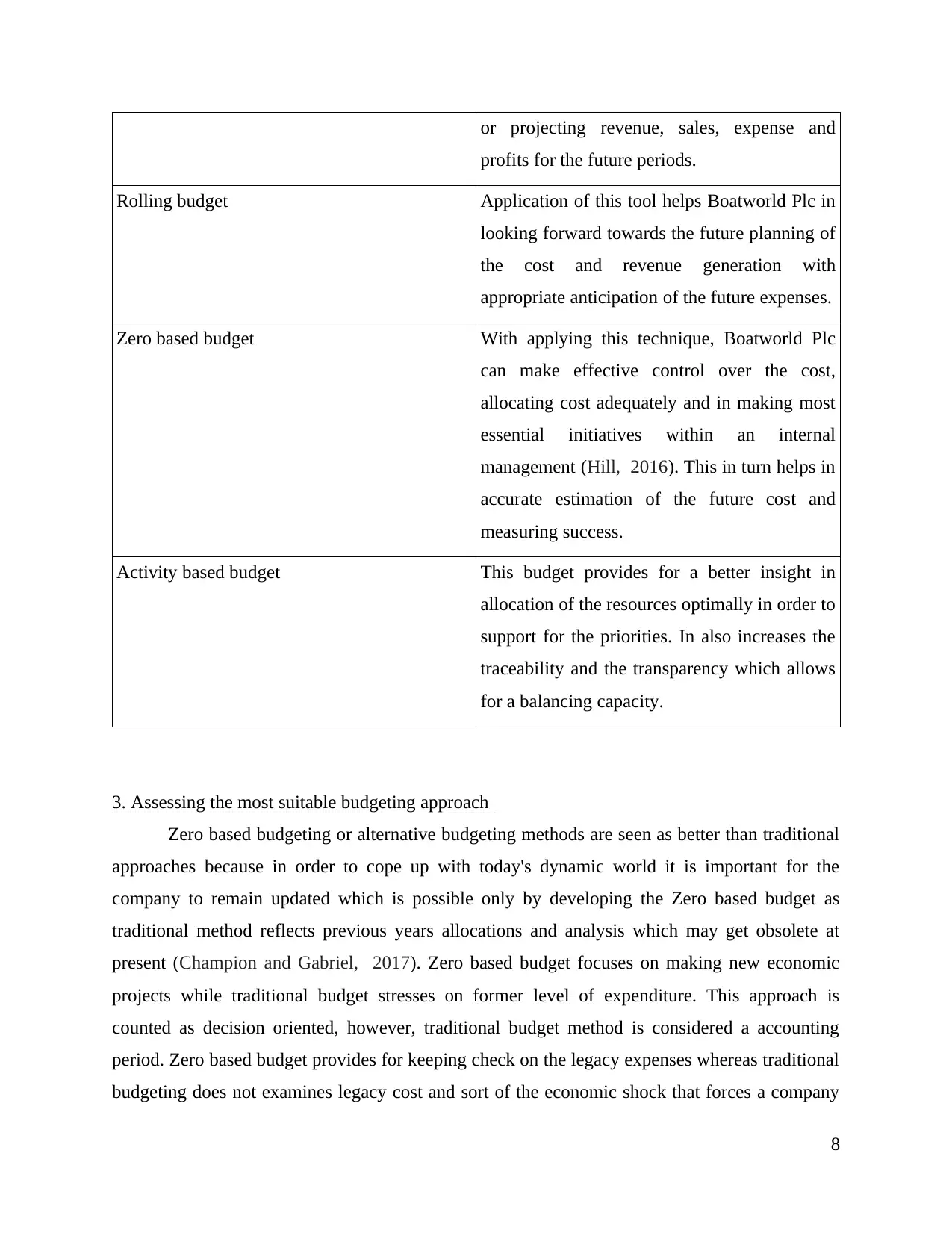
or projecting revenue, sales, expense and
profits for the future periods.
Rolling budget Application of this tool helps Boatworld Plc in
looking forward towards the future planning of
the cost and revenue generation with
appropriate anticipation of the future expenses.
Zero based budget With applying this technique, Boatworld Plc
can make effective control over the cost,
allocating cost adequately and in making most
essential initiatives within an internal
management (Hill, 2016). This in turn helps in
accurate estimation of the future cost and
measuring success.
Activity based budget This budget provides for a better insight in
allocation of the resources optimally in order to
support for the priorities. In also increases the
traceability and the transparency which allows
for a balancing capacity.
3. Assessing the most suitable budgeting approach
Zero based budgeting or alternative budgeting methods are seen as better than traditional
approaches because in order to cope up with today's dynamic world it is important for the
company to remain updated which is possible only by developing the Zero based budget as
traditional method reflects previous years allocations and analysis which may get obsolete at
present (Champion and Gabriel, 2017). Zero based budget focuses on making new economic
projects while traditional budget stresses on former level of expenditure. This approach is
counted as decision oriented, however, traditional budget method is considered a accounting
period. Zero based budget provides for keeping check on the legacy expenses whereas traditional
budgeting does not examines legacy cost and sort of the economic shock that forces a company
8
profits for the future periods.
Rolling budget Application of this tool helps Boatworld Plc in
looking forward towards the future planning of
the cost and revenue generation with
appropriate anticipation of the future expenses.
Zero based budget With applying this technique, Boatworld Plc
can make effective control over the cost,
allocating cost adequately and in making most
essential initiatives within an internal
management (Hill, 2016). This in turn helps in
accurate estimation of the future cost and
measuring success.
Activity based budget This budget provides for a better insight in
allocation of the resources optimally in order to
support for the priorities. In also increases the
traceability and the transparency which allows
for a balancing capacity.
3. Assessing the most suitable budgeting approach
Zero based budgeting or alternative budgeting methods are seen as better than traditional
approaches because in order to cope up with today's dynamic world it is important for the
company to remain updated which is possible only by developing the Zero based budget as
traditional method reflects previous years allocations and analysis which may get obsolete at
present (Champion and Gabriel, 2017). Zero based budget focuses on making new economic
projects while traditional budget stresses on former level of expenditure. This approach is
counted as decision oriented, however, traditional budget method is considered a accounting
period. Zero based budget provides for keeping check on the legacy expenses whereas traditional
budgeting does not examines legacy cost and sort of the economic shock that forces a company
8
Paraphrase This Document
Need a fresh take? Get an instant paraphrase of this document with our AI Paraphraser
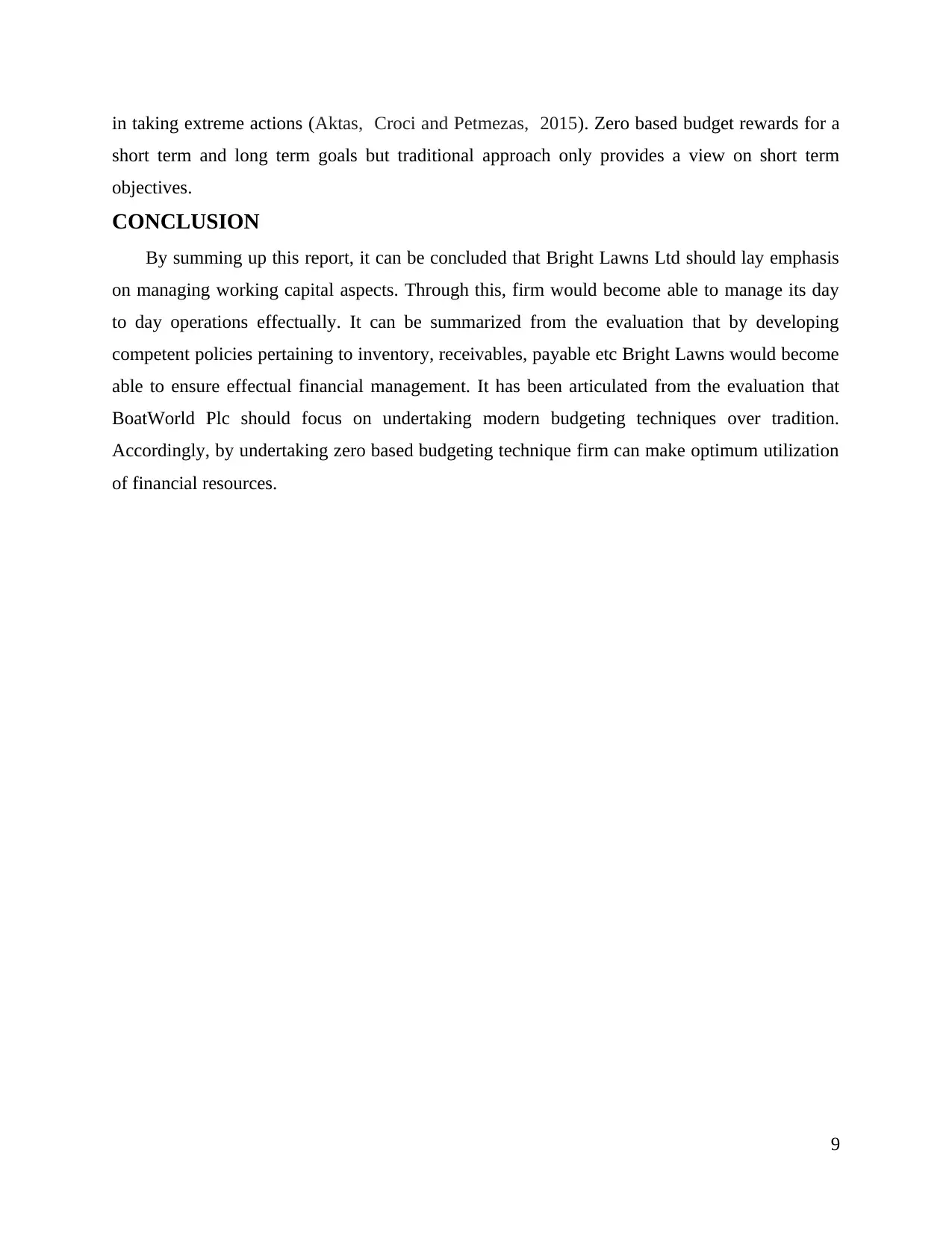
in taking extreme actions (Aktas, Croci and Petmezas, 2015). Zero based budget rewards for a
short term and long term goals but traditional approach only provides a view on short term
objectives.
CONCLUSION
By summing up this report, it can be concluded that Bright Lawns Ltd should lay emphasis
on managing working capital aspects. Through this, firm would become able to manage its day
to day operations effectually. It can be summarized from the evaluation that by developing
competent policies pertaining to inventory, receivables, payable etc Bright Lawns would become
able to ensure effectual financial management. It has been articulated from the evaluation that
BoatWorld Plc should focus on undertaking modern budgeting techniques over tradition.
Accordingly, by undertaking zero based budgeting technique firm can make optimum utilization
of financial resources.
9
short term and long term goals but traditional approach only provides a view on short term
objectives.
CONCLUSION
By summing up this report, it can be concluded that Bright Lawns Ltd should lay emphasis
on managing working capital aspects. Through this, firm would become able to manage its day
to day operations effectually. It can be summarized from the evaluation that by developing
competent policies pertaining to inventory, receivables, payable etc Bright Lawns would become
able to ensure effectual financial management. It has been articulated from the evaluation that
BoatWorld Plc should focus on undertaking modern budgeting techniques over tradition.
Accordingly, by undertaking zero based budgeting technique firm can make optimum utilization
of financial resources.
9
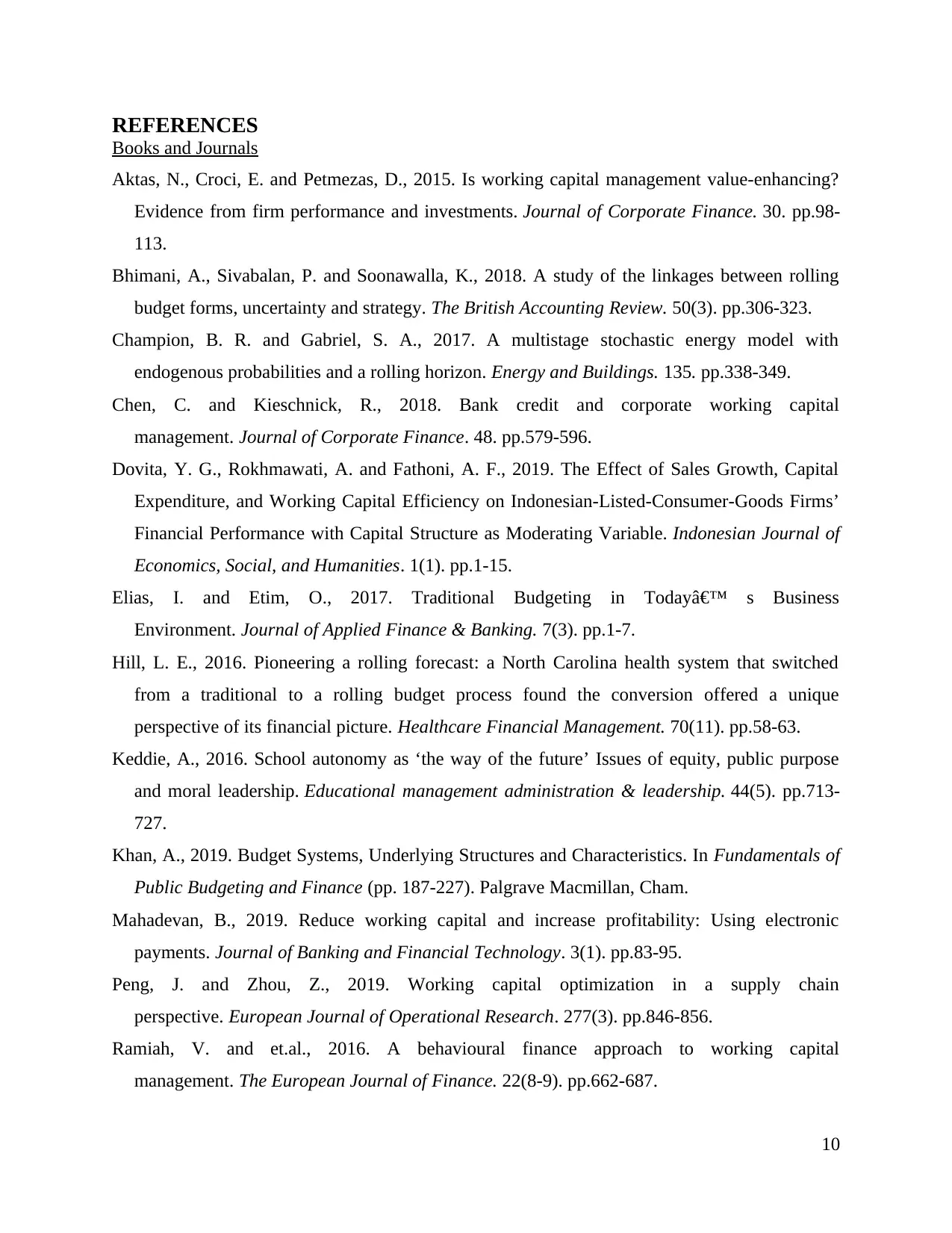
REFERENCES
Books and Journals
Aktas, N., Croci, E. and Petmezas, D., 2015. Is working capital management value-enhancing?
Evidence from firm performance and investments. Journal of Corporate Finance. 30. pp.98-
113.
Bhimani, A., Sivabalan, P. and Soonawalla, K., 2018. A study of the linkages between rolling
budget forms, uncertainty and strategy. The British Accounting Review. 50(3). pp.306-323.
Champion, B. R. and Gabriel, S. A., 2017. A multistage stochastic energy model with
endogenous probabilities and a rolling horizon. Energy and Buildings. 135. pp.338-349.
Chen, C. and Kieschnick, R., 2018. Bank credit and corporate working capital
management. Journal of Corporate Finance. 48. pp.579-596.
Dovita, Y. G., Rokhmawati, A. and Fathoni, A. F., 2019. The Effect of Sales Growth, Capital
Expenditure, and Working Capital Efficiency on Indonesian-Listed-Consumer-Goods Firms’
Financial Performance with Capital Structure as Moderating Variable. Indonesian Journal of
Economics, Social, and Humanities. 1(1). pp.1-15.
Elias, I. and Etim, O., 2017. Traditional Budgeting in Today’ s Business
Environment. Journal of Applied Finance & Banking. 7(3). pp.1-7.
Hill, L. E., 2016. Pioneering a rolling forecast: a North Carolina health system that switched
from a traditional to a rolling budget process found the conversion offered a unique
perspective of its financial picture. Healthcare Financial Management. 70(11). pp.58-63.
Keddie, A., 2016. School autonomy as ‘the way of the future’ Issues of equity, public purpose
and moral leadership. Educational management administration & leadership. 44(5). pp.713-
727.
Khan, A., 2019. Budget Systems, Underlying Structures and Characteristics. In Fundamentals of
Public Budgeting and Finance (pp. 187-227). Palgrave Macmillan, Cham.
Mahadevan, B., 2019. Reduce working capital and increase profitability: Using electronic
payments. Journal of Banking and Financial Technology. 3(1). pp.83-95.
Peng, J. and Zhou, Z., 2019. Working capital optimization in a supply chain
perspective. European Journal of Operational Research. 277(3). pp.846-856.
Ramiah, V. and et.al., 2016. A behavioural finance approach to working capital
management. The European Journal of Finance. 22(8-9). pp.662-687.
10
Books and Journals
Aktas, N., Croci, E. and Petmezas, D., 2015. Is working capital management value-enhancing?
Evidence from firm performance and investments. Journal of Corporate Finance. 30. pp.98-
113.
Bhimani, A., Sivabalan, P. and Soonawalla, K., 2018. A study of the linkages between rolling
budget forms, uncertainty and strategy. The British Accounting Review. 50(3). pp.306-323.
Champion, B. R. and Gabriel, S. A., 2017. A multistage stochastic energy model with
endogenous probabilities and a rolling horizon. Energy and Buildings. 135. pp.338-349.
Chen, C. and Kieschnick, R., 2018. Bank credit and corporate working capital
management. Journal of Corporate Finance. 48. pp.579-596.
Dovita, Y. G., Rokhmawati, A. and Fathoni, A. F., 2019. The Effect of Sales Growth, Capital
Expenditure, and Working Capital Efficiency on Indonesian-Listed-Consumer-Goods Firms’
Financial Performance with Capital Structure as Moderating Variable. Indonesian Journal of
Economics, Social, and Humanities. 1(1). pp.1-15.
Elias, I. and Etim, O., 2017. Traditional Budgeting in Today’ s Business
Environment. Journal of Applied Finance & Banking. 7(3). pp.1-7.
Hill, L. E., 2016. Pioneering a rolling forecast: a North Carolina health system that switched
from a traditional to a rolling budget process found the conversion offered a unique
perspective of its financial picture. Healthcare Financial Management. 70(11). pp.58-63.
Keddie, A., 2016. School autonomy as ‘the way of the future’ Issues of equity, public purpose
and moral leadership. Educational management administration & leadership. 44(5). pp.713-
727.
Khan, A., 2019. Budget Systems, Underlying Structures and Characteristics. In Fundamentals of
Public Budgeting and Finance (pp. 187-227). Palgrave Macmillan, Cham.
Mahadevan, B., 2019. Reduce working capital and increase profitability: Using electronic
payments. Journal of Banking and Financial Technology. 3(1). pp.83-95.
Peng, J. and Zhou, Z., 2019. Working capital optimization in a supply chain
perspective. European Journal of Operational Research. 277(3). pp.846-856.
Ramiah, V. and et.al., 2016. A behavioural finance approach to working capital
management. The European Journal of Finance. 22(8-9). pp.662-687.
10
⊘ This is a preview!⊘
Do you want full access?
Subscribe today to unlock all pages.

Trusted by 1+ million students worldwide
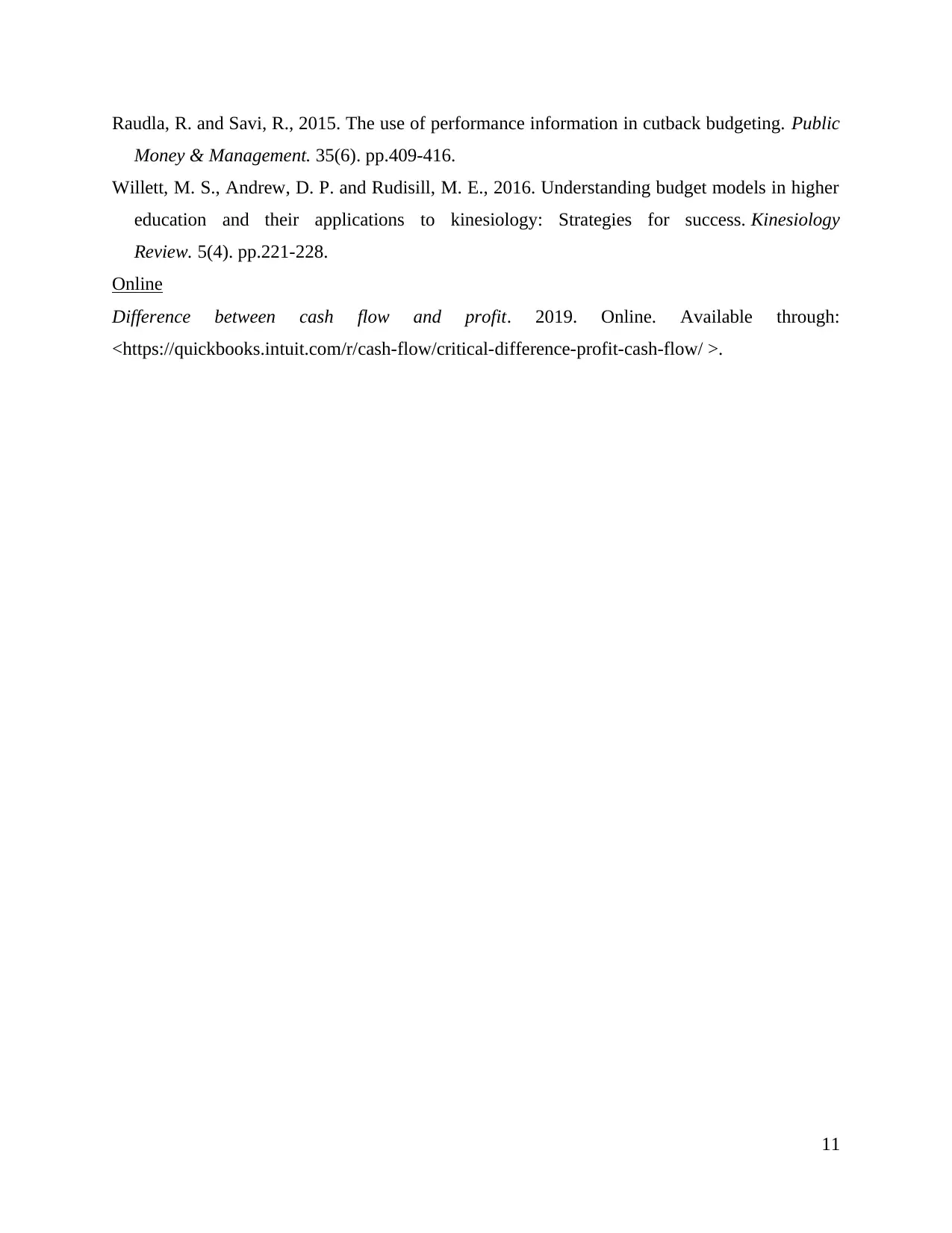
Raudla, R. and Savi, R., 2015. The use of performance information in cutback budgeting. Public
Money & Management. 35(6). pp.409-416.
Willett, M. S., Andrew, D. P. and Rudisill, M. E., 2016. Understanding budget models in higher
education and their applications to kinesiology: Strategies for success. Kinesiology
Review. 5(4). pp.221-228.
Online
Difference between cash flow and profit. 2019. Online. Available through:
<https://quickbooks.intuit.com/r/cash-flow/critical-difference-profit-cash-flow/ >.
11
Money & Management. 35(6). pp.409-416.
Willett, M. S., Andrew, D. P. and Rudisill, M. E., 2016. Understanding budget models in higher
education and their applications to kinesiology: Strategies for success. Kinesiology
Review. 5(4). pp.221-228.
Online
Difference between cash flow and profit. 2019. Online. Available through:
<https://quickbooks.intuit.com/r/cash-flow/critical-difference-profit-cash-flow/ >.
11
1 out of 13
Related Documents
Your All-in-One AI-Powered Toolkit for Academic Success.
+13062052269
info@desklib.com
Available 24*7 on WhatsApp / Email
![[object Object]](/_next/static/media/star-bottom.7253800d.svg)
Unlock your academic potential
© 2024 | Zucol Services PVT LTD | All rights reserved.




